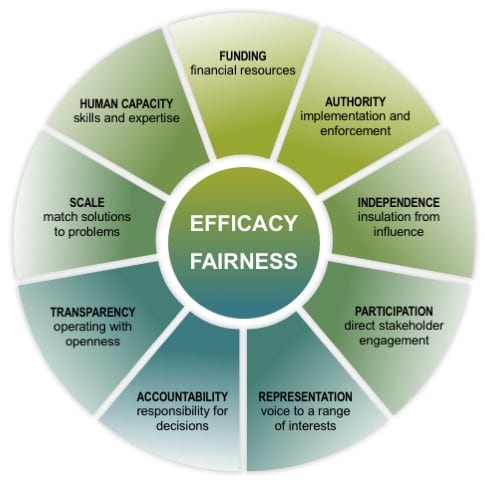March 2016
A new law requires California governments to form dozens of new agencies to manage groundwater. However, the law does not give them specific direction on what they will need to do, or how they can set themselves up for success. To address the need for guidance, we developed a framework to help these agencies prepare to manage this critical resource for the first time.
Background

With the passage of the Sustainable Groundwater Management Act (SGMA) in 2014, California adopts a historic policy of managing groundwater resources sustainably. This ambitious goal is critical to California’s water security, but major questions remain about how to achieve it. We argue that designing institutions for sustainable groundwater management is one of the most pressing near-term challenges for SGMA implementation. The new local Groundwater Sustainability Agencies (GSAs) required under SGMA will play a critical role in meeting groundwater sustainability goals. However, SGMA does not specify the details for institutional design of GSAs, nor what specific governance actions must be taken to achieve sustainability.
Because designing new institutions for good governance is not easy, the need for information and guidance is acute.
A framework for decision makers and stakeholders
The primary purpose of this document is to assist stakeholders and decision makers in evaluating the design of GSAs. It aims to empower them to think critically about whether proposed GSAs will meet their needs now and in the future, and—if not—which tools may help to achieve these goals. The framework presented here draws on experience in other natural resource management contexts and on research on governance and institutional design to provide lessons learned and illustrative examples.
 Local stakeholders and state agencies can use the nine criteria defined in this report to evaluate the institutional design of newly forming GSAs. These criteria support efficacy and fairness, two foundational elements of good governance. The criteria – scale, human capacity, funding, authority, independence, representation, participation, accountability, and transparency – form the basis for conceptual guidelines from which arise key questions that stakeholders and agencies can use to test the potential for a GSA to govern for groundwater sustainability.
Local stakeholders and state agencies can use the nine criteria defined in this report to evaluate the institutional design of newly forming GSAs. These criteria support efficacy and fairness, two foundational elements of good governance. The criteria – scale, human capacity, funding, authority, independence, representation, participation, accountability, and transparency – form the basis for conceptual guidelines from which arise key questions that stakeholders and agencies can use to test the potential for a GSA to govern for groundwater sustainability.
This report details the existing legal context for each of these criteria, and distills the criteria into a set of simple questions designed to help decision-makers and stakeholders evaluate the newly-forming GSAs.
The framework is intended to support GSAs and their stakeholders as they break new ground in sustainable governance of a crucial resource. With careful consideration of institutional design during the coming formative months, GSAs can hew to the spirit of local control that underlies SGMA, and retain local control and independence over the long term.
Download the Report
Executive Summary
Designing Effective Groundwater Sustainability Agencies – Executive Summary
Fresno Bee Op-Ed
California needs strong, fair and effective groundwater agencies (May 16, 2016)
Legal Planet Blog Post
The Devil is in the Design: Forming California’s New Groundwater Agencies (March 9, 2016)
Comments to DWR
Comments on DWR’s Draft Emergency Regulations for GSPs
Journal Article, Water
The Importance of Institutional Design for Distributed Local-Level Governance of Groundwater: The Case of California’s Sustainable Groundwater Management Act (September 30, 2018)
For More Information:
Contact Michael Kiparsky, Director, Wheeler Water Institute, Center for Law, Energy & the Environment
This project is part of the UC Water Security and Sustainability Initiative and supported by the University of California Office of the President